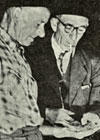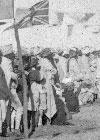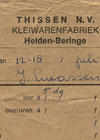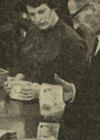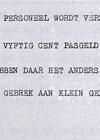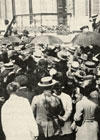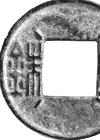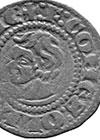Visualizing Wage Payments
In Wages and Currency. Global Comparisons from Antiquity to the Twentieth Century, an interdisciplinary project involving social and economic history as well as numismatics, it has been shown how important coin circulation patterns can be for the actual payment of wages.
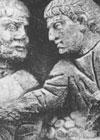
 Click on the illustration for a larger picture and more information
Click on the illustration for a larger picture and more information
Remarkably, in the past the actual payment of wages has been visualized only very rarely. The only scenes of actual payment of coins mostly pertain to the doles, e.g. to the citizens in classical Rome (ill. 1) or to payments at market places, like in classical China (ill. 2), rather than payments for work done or services rendered. Out of the rare documents that are nevertheless available, a selection has been made, covering for the most part the last two centuries only and with an emphasis on the West.
Payments can be done individually (ills. 3-5), or collectively (ill. 6).
The logistics of wage payments in large firms involved the use of pay packets (ill. 7), which had to be filled (ill. 8) and to be handed out to the right persons at the actual payday (ill. 9).
For small employers moneychangers were indispensable for the procurement of the necessary denominations (ill. 10). In principle, the employer has to pay out the exact sum, because the wage earner is not supposed to have change at payday (ill. 11). If coins suddenly become unavailable, like at the start of the First World War, the consequences are immediately felt at payday (ills. 12 - 13).
Worldwide two coin systems have been developed: in East Asia exclusively small copper coins (so called "cash") which - through the hole in the middle - could be strung to bigger units (ills. 14 - 15); in South Asia, West Asia, Europe and eventually everywhere multi-denominational systems. In the latter case, research so far suggests that - whether wages were paid out daily, weekly, or fortnightly - wage earners tended to receive their remunerations in denominations equaling one half, one full, or two daily wage rates. Those particular fractions dominated coin production and coin circulation, as may be exemplified by the case of the Netherlands between 1200 and 1900 (ills. 16 - 17).
For the greater part of history currencies in which wage payments were done consisted of coins. However, from the beginning of the twentieth century paper money started to be used for the payment of salaries and wages (ill. 18). But this device too lost its significance with the introduction of giro and bank transfers beyond the realm of commerce. The shift from cash payments to wage transfers via bank or giro started in the United States (ill. 19), and spread after the Second World War to Britain and other prosperous countries in Western Europe. Thus within a few decades, the actual pay packet largely disappeared in that part of the world (ill. 20).



In the framework of the Global Labour History project (see also the book Global Labour History and the text Prolegomena) the question now can be raised, to what extent can extension seen in the circulation of medium- and small-denomination coins provide an indication of the occurrence of wage payments, in particular in cases where other sources for study of the phenomenon are lacking, e.g. non-European parts of the world before c 1900.
Text and compilation: Jan Lucassen
Sources and further reading:
- Lucassen, Jan (ed), Wages and Currency. Global Comparisons from Antiquity to the Twentieth Century. International and Comparative Social History, vol.10. Bern [etc.]: Peter Lang, 2007. ISBN 978-3-03910-782-7, 474 pp.
- Lucassen, Jan, Loonbetaling en muntcirculatie in Nederland (1200-2000) in: Jaarboek voor Munt - en Penningkunde 86, 1999, (1-69), Amsterdam. IISH call number: Bro 4166/1
- List of Datafiles of Historical Prices and Wages maintained by Jan Luiten van Zanden
- A Global Collaboratory on the History of Labour Relations in the period 1500-2000
- Geldmuseum Utrecht

